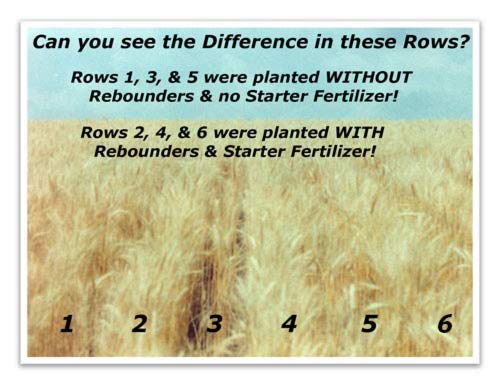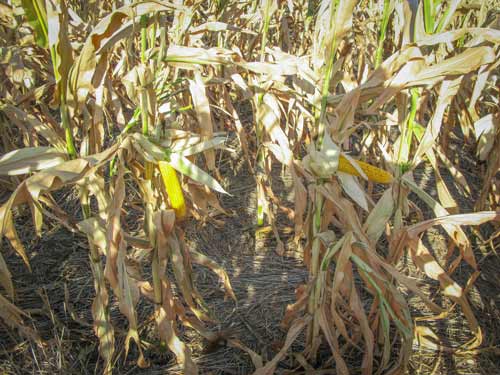Rebounders
This photo was taken on a farm in southern Illinois.
The row on the left was planted with a firming attachment. As you can see, it suffers from:
- Seeds not all centered in the bottom of the furrow
- Bunching of seeds
- Inconsistent seed spacing
- Inconsistent seed depth: Some seeds are pressed into the side wall up 1/2″-3/4″ while some are pressed deeper than the seed V
- Uneven emergence
The row on the right was planted with Rebounders. This row shows:
- Consistent seed depth & spacing
- Uniform emergence

Wheat

Notice the difference in the odd rows: 1, 3, and 5. They were planted without Rebounders and had no starter fertilizer.
The even rows: 2, 4, and 6 were planted with Rebounders and had starter fertilizer.
Corn
This photo shows the difference in corn when left untreated vs. planted using Rebounders and the Y-Not Split-It fertilizer attachment with Conklin AgroVantage® fertilizer.
Photos supplied by Bob Waltemath of the Conklin Company.


Canola
The following photo shows a field of Safran hybrid canola.
To the left of the red line was planted with Rebounders and 2.5g of Riser fertilizer through the Y-Not Split-It attachment.
There was no fertilizer applied to the field to the right of the red line.

Millet
 Our friends at Grainland Coop in Holyoke, CO noticed the difference in planting and fertilizing millet using Rebounders with Straight Shot attachments. Here is their story:
Our friends at Grainland Coop in Holyoke, CO noticed the difference in planting and fertilizing millet using Rebounders with Straight Shot attachments. Here is their story:
Agronomy salesman Randy Shaw received a phone call from Brent Vieselmeyer, of Vision Angus, who was extremely pleased with his millet fields. Brent applied 4oz of Ascend in-furrow with his Crustbuster 4000 series drill using Rebounders and Straight Shot attachments. Randy Shaw and Yield Point Agronomist Taylor Horton went out to Brent’s fields and this is what they saw!!
The top picture shows the roots of millet that were treated with Ascend vs. millet that was not treated. The treated plants on the left clearly have more biomass, deeper penetrating roots and more root hairs vs. the untreated plants on the right.
The bottom picture demonstrates the even emergence and growth of millet treated with Ascend in-furrow using Rebounders and Straight Shot attachments.
Straw on Dryland Corn
The pictures below show a dryland field of corn on August 22, 2013 that the wheat was harvested in July of 2012 with a combine that had a 40′ draper head. These pictures show the center of the combine where all the straw came out of the IH combine and out away from the center where the chaff and straw didn’t get to the last 10′ on each side of the center 20′. The corn was planted north and south and the combine went east and west when cutting the wheat.




The corn is nearly all burned up on the outer 10′ with only nubbins or ears that are only about 3″ long and have very small kernels on them. The corn in the middle of the draper has ears that are at least 10″ long with large kernels on them. This is proof that the straw makes a big difference when it comes to a drought year like this one (approx. 4″ of rain since the first of the year).
This image shows the ears in the two different areas where the draper head went across the rows of corn. In the center 20′ of the 40′ draper head where the combine spread the straw the ears are 54 kernels long and 20 rows around. The outer 10′ have ears that average 18 kernels per row and 18 rows around. This is a significant difference! Some of the rows on the small ears are not filled around the whole cob, so that makes them even less kernels per row.

